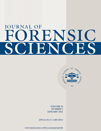Association of Ignitable Liquid Residues to Neat Ignitable Liquids in the Presence of Matrix Interferences Using Chemometric Procedures* ,†
Funded by the Midwest Forensic Research Center (DE-AC02-07CH11358).
Presented at the 61st Annual Meeting of the American Academy of Forensic Sciences, February 16–21, 2009, in Denver, CO.
Abstract
Abstract: In fire debris analysis, weathering of ignitable liquids and matrix interferences can make the identification of ignitable liquid residues (ILRs) difficult. An objective method was developed to associate ILRs with the corresponding neat liquid with discrimination from matrix interferences using principal components analysis (PCA) and Pearson product moment correlation (PPMC) coefficients. Six ignitable liquids (gasoline, diesel, ultra pure paraffin lamp oil, adhesive remover, torch fuel, paint thinner) were spiked onto carpet, which was burned, then extracted using passive headspace extraction, and analyzed by gas chromatography-mass spectrometry. Both light and heavy burn conditions were investigated. In the PCA scores plot, ignitable liquids were discriminated based on alkane and aromatic content. All ILRs were successfully associated with the corresponding neat liquid using both PCA and PPMC coefficients, regardless of the extent of burning. The method developed in this research may make the association of ILRs with corresponding neat liquids more objective.




